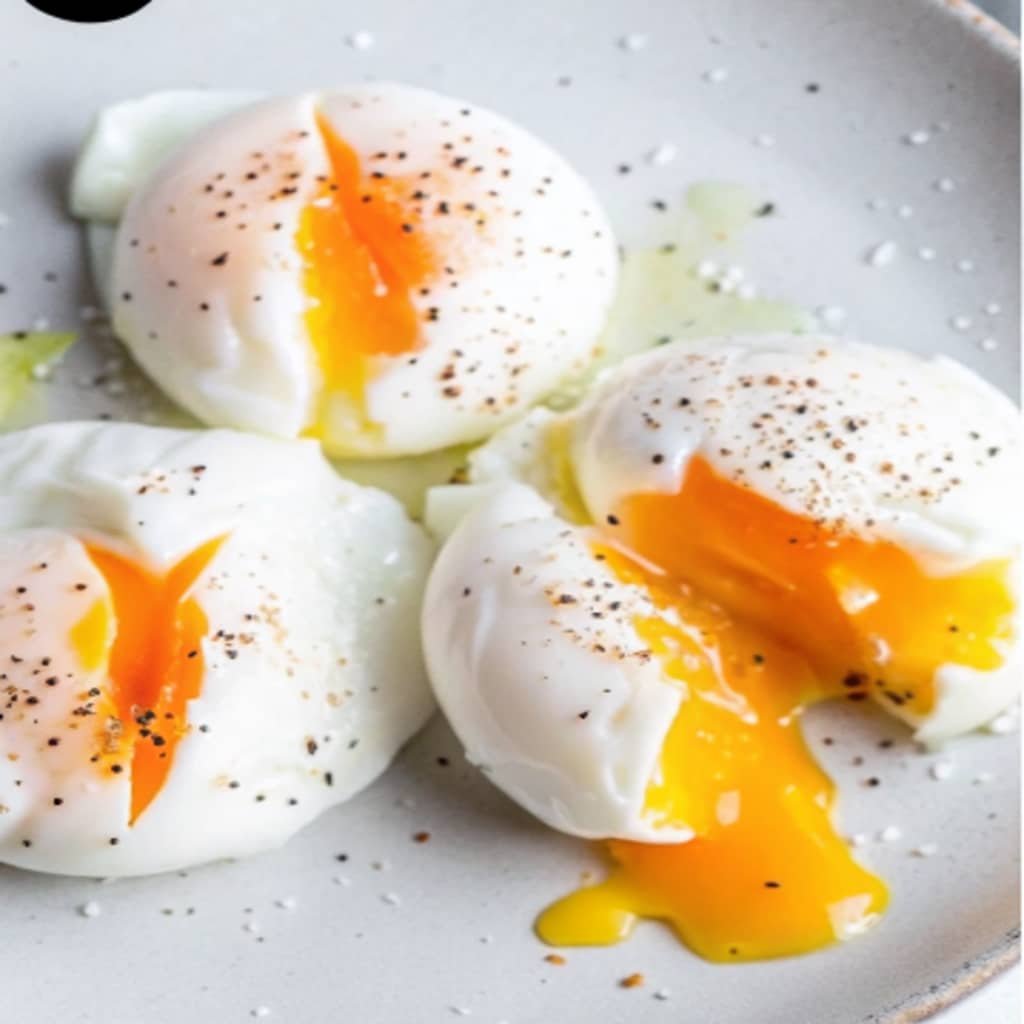There’s something quietly elegant about a perfectly poached egg. No sizzle, no oil — just a whisper of simmering water and a swirl of patience. The result? A tender white that hugs a golden, velvety yolk that spills like sunshine when your spoon breaks through.
I still remember the first time I mastered them. I’d been baking sourdough all morning, the kitchen smelled like warm bread, and I thought — “Wouldn’t a poached egg on top make it even better?” (Spoiler: it did.)

Now, poached eggs are my go-to for busy mornings and weekend brunches alike. Whether you serve them over toast, grain bowls, or greens, they make everything feel a little more special — even Tuesday breakfast.
Table of Contents
Why You’ll Love Making Poached Eggs at Home
- Simple ingredients, big payoff: Just eggs, water, and vinegar.
- Healthy cooking method: No oil, no butter — just steam and patience.
- Restaurant-quality at home: Once you know the trick, you’ll never go back.
- Versatile: Perfect over avocado toast, salads, ramen, or roasted veggies.
- Quick: Ready in under 5 minutes.
If you love slow breakfasts and cozy brunches, pair these with Best Cottage Cheese Bagels or crusty Sourdough Baguette — both make the perfect base for that dreamy yolk drizzle.
Ingredients
- Fresh eggs (the fresher, the better — firm whites are key)
- 1 tablespoon white vinegar (optional, helps whites set faster)
- Water (enough to fill a saucepan about 3 inches deep)
- Salt and pepper, for serving
Optional toppings:
- Avocado slices
- Everything bagel seasoning
- Hollandaise sauce
- Chopped chives or parsley
Step-by-Step Instructions
- Heat the water:
Fill a medium saucepan with 3 inches of water and bring to a gentle simmer (not a rolling boil). You should see tiny bubbles on the bottom — around 180–190°F (82–88°C). - Add vinegar (optional):
Pour in 1 tablespoon of white vinegar. It helps the egg whites firm quickly and stay together. - Crack the egg into a small bowl:
Don’t crack directly into the water — using a bowl ensures the yolk stays intact. - Create a gentle swirl:
Stir the water with a spoon to make a small whirlpool in the center. This helps the white wrap neatly around the yolk. - Slide the egg in:
Lower the egg gently into the swirling water. Let it settle undisturbed for 3–4 minutes, depending on desired doneness. - Lift and drain:
Use a slotted spoon to lift the egg out. Gently blot the bottom with a paper towel to remove excess water. - Serve immediately:
Sprinkle with salt, pepper, and any favorite toppings.
How to Serve Poached Eggs
There’s no wrong way to serve a poached egg — only delicious ones.
For a simple breakfast, spoon it over buttered toast or avocado slices. If you’re feeling fancy, make a café-style plate with sautéed greens and roasted tomatoes.
They’re also stunning on top of grain bowls, soups, or even salads — that creamy yolk doubles as dressing.
One of my favorite combos? A freshly toasted Sourdough Baguette, sliced thick, topped with mashed avocado, a poached egg, and a sprinkle of flaky salt. Heaven.
Or for a balanced breakfast, try it with a warm muffin like Easy Blueberry Muffins and coffee — the perfect sweet and savory start to your day.
How to Store and Reheat Poached Eggs
Freshly poached eggs are best enjoyed right away, but you can make them ahead with a few tricks.
- To store: Transfer cooled poached eggs to a bowl of cold water. Cover and refrigerate for up to 2 days.
- To reheat: Place them in simmering water for 30–45 seconds until warmed through.
- Freezing: Not recommended — the texture changes too much.
Meal prep hack: Poach eggs ahead on Sunday, keep them in water, and reheat for easy weekday breakfasts. Just toast your bagel, add avocado, and top with a warm egg — breakfast in under 3 minutes!
Tips for Perfect Poached Eggs
- Use fresh eggs: Older eggs spread out more in water.
- Keep the water calm: Vigorous boiling breaks the whites.
- Add vinegar: Helps the white coagulate faster.
- Don’t overcook: 3–4 minutes = runny yolk; 5–6 minutes = firmer yolk.
- Swirl for shape: The whirlpool method keeps your egg neat.
- Drain before serving: A quick blot keeps your toast from getting soggy.
- Cook one at a time (or two max): Crowding lowers water temp and leads to uneven results.
Bonus tip: Use a fine-mesh strainer to remove watery egg whites before poaching — this guarantees restaurant-worthy results every time.
Variations
- Classic Eggs Benedict: Serve on English muffins with Canadian bacon and hollandaise sauce.
- Mediterranean: Place over hummus and roasted veggies.
- Green Goddess: Top with avocado, herbs, and lemon zest.
- Asian Style: Add to ramen or pho for a silky finish.
- Spicy Southwest: Layer over black beans, salsa, and cilantro.
Poached eggs adapt beautifully — from fancy brunch plates to quick weeknight dinners. They’re humble but versatile, proving that sometimes the simplest things are the most rewarding.
FAQs
Q1: Why do my poached eggs fall apart?
The water might be boiling too hard, or your eggs aren’t fresh. Keep the simmer gentle and use a splash of vinegar.
Q2: How long do I poach eggs for runny yolks?
3–4 minutes yields a soft yolk; add a minute for firmer texture.
Q3: Can I poach eggs without vinegar?
Yes — it just might spread a bit more, but still tastes great.
Q4: Can I poach multiple eggs at once?
Yes, up to 3–4 in a large pot, but make sure the water stays hot and don’t stir after adding them.
Final Thoughts
Perfect poached eggs aren’t about fancy tools or special tricks — they’re about slowing down and finding joy in the small, quiet moments of cooking.
Once you master them, you’ll always have a quick, elegant, and satisfying meal just a few minutes away.
Follow me on Facebook and Pinterest where I share cozy, easy-to-make baking recipes just like this one.
Print
Poached Eggs
- Total Time: 9 minutes
- Yield: 2 servings 1x
Description
Perfectly poached eggs—silky whites and golden, runny yolks. Quick, healthy, and foolproof for breakfast or brunch.
Ingredients
- 2 fresh eggs
- 1 tbsp white vinegar (optional)
- Water for poaching
- Salt and pepper to taste
Instructions
1. Fill a saucepan with 3 inches of water and bring to a gentle simmer.
2. Add vinegar (optional) to help whites set.
3. Crack eggs into small bowls.
4. Stir water to create a gentle whirlpool.
5. Slide eggs into the center one at a time.
6. Cook 3–4 minutes for runny yolks or 5–6 minutes for firm.
7. Remove with slotted spoon, drain on paper towel, and season.
Notes
Use the freshest eggs for best results.
Keep the water at a gentle simmer, not a rolling boil.
Serve immediately over toast, salads, or grain bowls.
- Prep Time: 5 minutes
- Cook Time: 4 minutes
- Category: Breakfast
- Method: Poaching
- Cuisine: American
Nutrition
- Serving Size: 1 poached egg
- Calories: 140
- Sugar: 0g
- Sodium: 160mg
- Fat: 10g
- Saturated Fat: 3g
- Unsaturated Fat: 5g
- Trans Fat: 0g
- Carbohydrates: 1g
- Fiber: 0g
- Protein: 12g
- Cholesterol: 370mg
